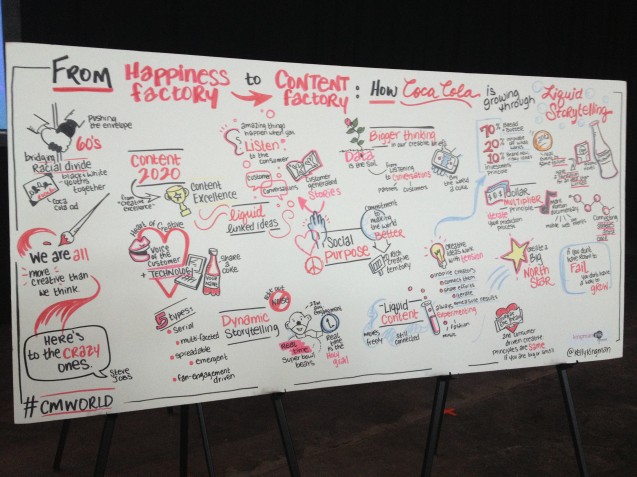Content Marketing World was nothing short of sensational this year. We heard from a strong variety of marketing thought leaders who dropped the hammer on content thinking, provided actionable ideas for tough, modern challenges and spoke about the future of content marketing.
Before we get into the juicy stuff, let’s dish out some respect to Content Marketing Institute for putting on such an action-packed show and providing stellar entertainment at venues like the Rock & Roll Hall of Fame Museum and the House of Blues. The marketing of the actual event was top notch. Even the Cleveland Indians caught the vibe. Seriously, respect.
Keynote Speakers
William Shatner – Actor, Director, Producer and Author
We’re reaching out to build a personal relationship by exploring personal relationships both ours and theirs.
Shatner talked about how he marketed wine by having a musician describe the wine by playing in his saxophone – to play what he felt, tasted and experienced soon after sampling the wine. The fascination is selling the wine by not talking about it.
He talked about selling a watch. How it’s not about selling a watch but how this watch can mark the passage of time for generations to come because this is a watch to be valued. It isn’t a “punch in the head” sales technique. It’s a story that uniquely sells the product. There’s artistry in making and artistry in selling the product. Both are equally important!
“I’ve evolved as an actor into making every word count. I have these two puppies. I’ve taken into watching the puppies in the way that they interact and speak to each other in non-verbal language. Every dart of their eye or glance is meaningful. Everything is in play.”
Most marketers are so busy cranking out the story that they completely ignore the back story. The back story needs to be as interesting as the story itself, and should convey in a non-verbal way the message you are trying to deliver.
In essence: A good story always prevails.
Jonathan Lister – LinkedIn
LinkedIn is going “all in” in content marketing to connect the world’s professionals and make them more productive. And they’re doing that by putting members first.
LinkedIn has incorporated visual into their content marketing strategy. There’s great content marketing and less great content marketing. What often differentiates those two is often nothing more than an awesome visual.
What really matters in content marketing is to always be helping. Change the mantra from “always be closing, to always be helping.”
“Speak to the dog, in the language of the dog, about what’s in the heart of the dog.” – Ted Williams
Your insights should driven from connections, engagements and commonalities. We don’t need more content. We need more relevant content, and here’s how:
- Have content that’s waiting for a moment where there’s a dead spot you can fill.
- Have content that’s in the moment. “You can still dunk in the dark” Oreo campaign.
- Have content that’s anticipating the moment – conversations that are bubbling up, products that are up and coming, etc.
If you are experiencing an increase in referral traffic or social engagement then you know you’re doing things right.
Jay Baer – Youtility
Be smart marketers. Smart marketing is about help not hype!
“If you sell, you’ll have a customer for one day. If you help, you have a customer for life.”
Youtility comes from insight, not data. Research to know what customers need and how you can address that need.
Types of Utility
- Self-serve information: People are hungrier than ever and if they have to call your business, you’re doing it wrong.
- Radical transparency: Proactively address problems. Remember, trust is the prism all business decisions must pass through.
- Real-time relevance: Be the ultimate solution, sometimes. Is your marketing so useful that people would pay for it?
Promote utility first, company second.
Bottom line: “Stop creating content, start creating utility.”
Don E. Schultz – Northwestern University
Content is the key to brands and branding moving forward.
A recently released study of 1,500 brands revealed that preference scores have dropped. More and more people are claiming “No Brand Preference”. Three companies are still doing it well – Kleenex, Gatorade and Charmin.
We’re seeing a major decline in traditional media usage – TV, magazines, etc. and a strong incline in new media. The challenge with new media is that social media – Facebook, Twitter, YouTube and the like don’t create or support the brand concepts that built brands in the first place. This includes brand concepts, brand messaging and brand imagery.
Social Media fragments and separates.
Brand matters, go back to being good storytellers. Find out how your customers are influenced. Content marketing is the future of marketing. You must tell compelling stories to engage the consumer.
Jonathan Mildenhall – The Coca-Cola Company
“Amazing things happen when you listen to the consumer.”
Definition of Content: The creation of stories that are to be expressed through every relevant connection. The substance of brand engagement and brand development.
Liquid Content: Elements of content that move freely amongst themselves in their environment.
5 Principles for Content Development
- Inspire the greatest minds to work with us
- Connect those creative communities together
- Share the efforts of our learning
- Continue development
- Measure our success.
Iterate, iterate, iterate your production process. Don’t just replicate the same content on different screens. Your content needs “tentpole” productions and also “tent stake” productions.
We need to create liquid ideas that give our brand a disproportionate share in the market.
“If you don’t have room to fail, then you don’t deserve to grow.”

Speaking of liquid storytelling, one of the show’s highlights was graphic recorder Kelly Kingman who illustrated the presentations of selected keynote speakers. She’s fantastic.
More Speakers
Lee Odden – TopRankMarketing.com
Effective content is all about storytelling, it creates experiences. Content is anything that adds value to the reader’s or viewer’s life. It’s not objects or things. You’re doing it in a specific way for a specific audience.
Content is the KINGDOM – 100 Billion Searches/month. Content is the reason search was created.
How do customers discover, consume and react to your content?
- State 1: DISCOVERY – Keywords, social topics, advertising, publications, events, word of mouth
- Stage 2: CONSUMPTION – Text, images, audio, video, mobile, tablet, computer, formal, funny, long, short
- Stage 3: REACTION – Social share, engage, comments, subscribe, register, inquire, buy.
Hold your content accountable for its ability to attract, engage and convert. It might just be a micro-conversion, like a share or a comment, but it’s still a conversion.
The Future of Content
- We expect an increase in author authority influence on search visibility
- More structured data like schema.
- Increase in brand publishers to an extent that they actually compete with big publications in their industry
- Publishers selling marketing services and platforms
- Big increase in native ads and sponsored content
- Visual – Tablespoon.com by General Mills (rich imagery, videos promoting their own products.
Doug Kessler – Velocity Partners
The biggest threat to content marketing is content marketing, or crap content.
Behind every successful content marketing campaign is a home run piece. How do you hit a home run? By creating content that elicits an emotion, energy, confidence and attitude.
Out heart and our gut make the decision, then comes along our head that tries to add logic to that decision – the psychology of decision making. Hence, head + heart (passion, wonder, fear, joy, intrigue, frustration, hate) = Home run content.
Creating a rant piece can stir people to action by getting them to WAKE UP and focus on you.
Joe Chernov – Kinvey Design
Stellar management tools to consider: Percolate, LookBookHQ, Uberflip, Contently
Scalable distribution or “amplification” platforms: Little Bird, Papershare, Addvocate, Influitive
Solid analytics tools to check out: Optimizely, Trackmaven
Dr. Cheemin Bo-Linn – Peritus Partners
Main Takeaway: “Our success relies on us understanding the DNA of the user.”
Content is king, creative is queen and Big Data is the knight. Reaching a user with messaging that is relevant to what they are doing in that very moment.
Now that we have the tools, we must begin to distill Big Data from abstract to concrete using contextual content data marketing and focus on testing and optimization. There’s so much data out there to mine through – 10 terabytes of Facebook data daily and data across all social media is on the rise. Research reveals true customer behavior patterns.
“Information is not knowledge and data without context is just organized information.” – Albert Einstein
Heidi Cohen – ClickZ, NYU, Riverside Marketing Strategies
Heidi has 21 extremely useful tips and tricks to make your content marketing more effective. Take a minute to go through this list because it will set your sails straight.
Preface: Content is exploding. The average person consumes 10.7 hours of content/day. The amount of mobile devices has doubled since 2010. 83% of learning occurs visually! YouTube is the second largest social network and search engine.
- Set specific goals
- Know your target audience – market persona
- Provide information customers actively seek
- Plan for different content formats (visually stimulating)
- Use variety of publishing platforms (YouTube, LinkedIn)
- Build Content Assets – Can your business survive without Google?
- Consider ALL of your resources
- Offer useful content at every purchase step
- Tell stories people relate to – your “once upon a time”
- Crowdsource content
- Curate content with care
- Brand your content
- Don’t just wing content creation – you need a plan
- Plan content reuse in advance
- Avoid THDR (too hard didn’t read)
- Optimize for findability
- Plan content distribution – 20% creation/80% distribution principle
- Encourage social sharing – list.ly
- Promote your content
- Motivate them to respond – call to action
- Measure results – track back to initial goals
Bonus: Test to improve conversion
The content marketing cycle:
- Build strategy
- Create content
- Execute content
- Cistribute to Distribute
- Measure and revise





